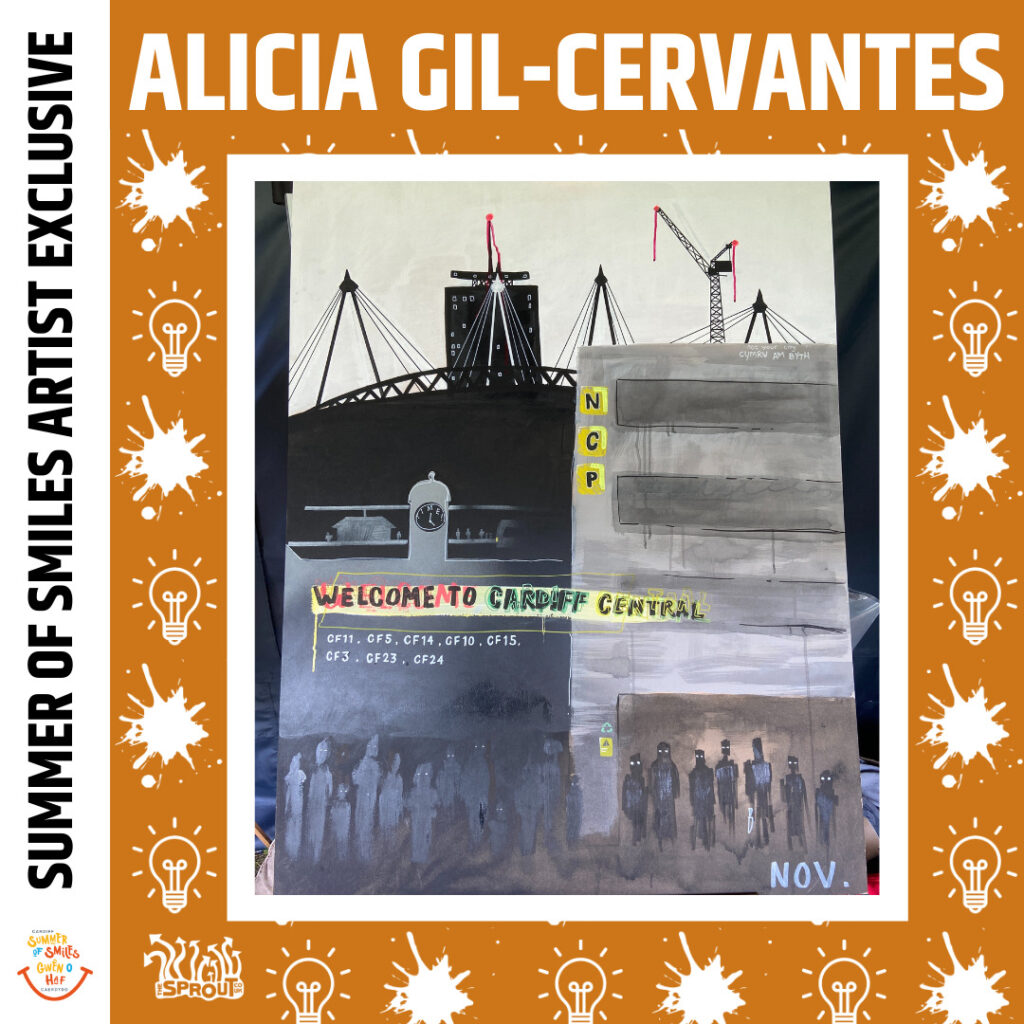18-year-old Alicia Niebla Gil-Cervantes pooled her resources into creating a masterpiece which reflects the good, the bad and the ugly in Cardiff. As with everywhere, the city isn’t perfect, and Alicia didn’t want us to lose sight on the issues that can make Cardiff less desirable.
She tells TheSprout she has seen the different sides of Cardiff, and this influences her work.
“I have seen various sides of Cardiff and I know both the ugly and the beautiful. The Ugly being postcode wars, drug abuse, gang violence, poverty, dirt, and squalor. The beautiful being unity in the communities, all the beautiful parks and the nature in the city.”
Cardiff through Art
Alicia’s work is inspired by her own experiences of Cardiff, both good and bad. The piece itself depicts the view from her bedroom, with all the iconic buildings in Cardiff side-by-side, reflecting the tightness of the different communities in Cardiff. She tells us that many of these sights in Cardiff have become familiar sightings.
“Because it’s a small city you can more easily see people’s stories develop from a distance. Due to its size, you often see people again and again. You get to know those who linger in the city centre, for good or for bad. There are also romantic areas in Cardiff such as the Castle and the arcades. I see many long-time Cardiff family business such as The Lazarou Brothers and Barker’s Coffee.”
Alicia wanted to stress that Cardiff isn’t all bad, and her family has been here since 1967, meaning her father was just four when he arrived in Cardiff. She feels proud to call this diverse city her home, as she emphasises.
“My family are immigrants to Cardiff, and I have always mixed with people from many backgrounds. Cardiff is made up of very different areas. Some are very multicutural such as Butetown and Grangetown.”
Although, she hastens to add that Cardiff extends beyond these areas, and the bigger picture regarding relations within the city is often overlooked.
“Some areas are pre-dominantly white. It is clear that Cardiff is segregated.”
“But I also feel that Cardiff has given me the ability to acknowledge that I can protest and have and use my voice.”
The Magnum Opus
The piece, itself, is slightly different to all the others which are on display at Summer of Smiles. In a literal sense, it is the biggest, it is the darkest and it has taken pride of place in the centre of TheSprout’s tent.
It is also equally big and dark in a metaphorical sense, with the inclusion of blood dripping from the tops of cranes with people queuing like lemmings at the bottom of an NCP car park.
Alicia tells us she physically scouted the areas in and around the City Centre as sources of inspiration.
“I spent some time to think through my experiences of Cardiff and create some observational sketches, which formed the base of my art as I developed them over time. I had to be flexible with my creativity for the best outcome to develop.”
“Then, I spent some time in the City Centre to carry out some observations. I had an initial thought of painting of homeless people but, again, that had to be informed by observations. I hope this has prevailed as a good metaphor of poverty in a beautiful city.”
So, Alicia’s art offers an accurate reflection of what the city means to her, and how she views all aspects of life here. After all, that is what she was commissioned to do.
Inspirations
Her calculated approach may be inspired by other artists. Taking such an approach whereby the process of creating a work of art has proved to be a stroke of genius.
“I went to see the work of Grayson Perry in Bristol, who worked with young people, communities and the police to create artwork on the difficulties and lives of young people who are involved in gang violence and postcode war – the work was called, Kings of Nowhere.”
“It was interesting to see how he spent his time researching and getting to know what was going on before committing to do the work.”
The moral of Alicia’s art, and of the experiences that have guided her on the creation of this conveyance of Cardiff, is that nothing is perfect.
There are two sides to every coin, and this city is not exempt. Perhaps the duplicity of our streets is a natural state of being, but that isn’t necessarily a bad thing. Everyone you walk past on the street will have had different experiences, and life would be boring if we all experienced the same things. There would be nothing for us to talk about when we meet new people.
Perhaps duplicity is the wrong word to use, because there may be more than two sides to this city.
Anyway, Alicia’s piece has definitely been a talking point at the festival. It has provoked a discussion that will never come unstuck. Its contemporary relevance has certainly struck a chord or two this exhibition week.
“I wanted to present the brutal truth of Cardiff and make it relatable to some of the young people in Cardiff. The people I have tried to represent here need a voice, and I hope my art has done that.”
Related Information
If you’d like to see more about our artists and their work, check out Rosie’s, Faaris’, Saabiqah’s Eshaan’s, Farah’s and Nalani’s work.

